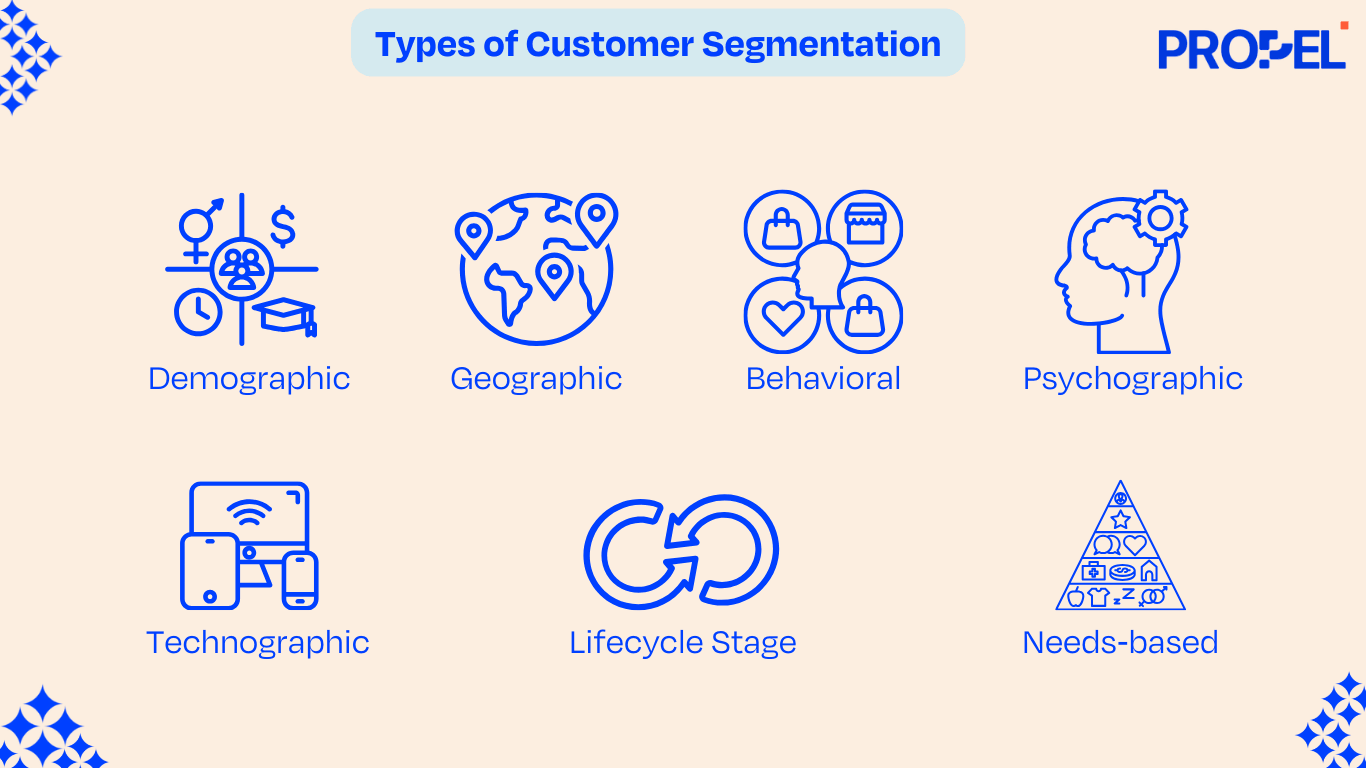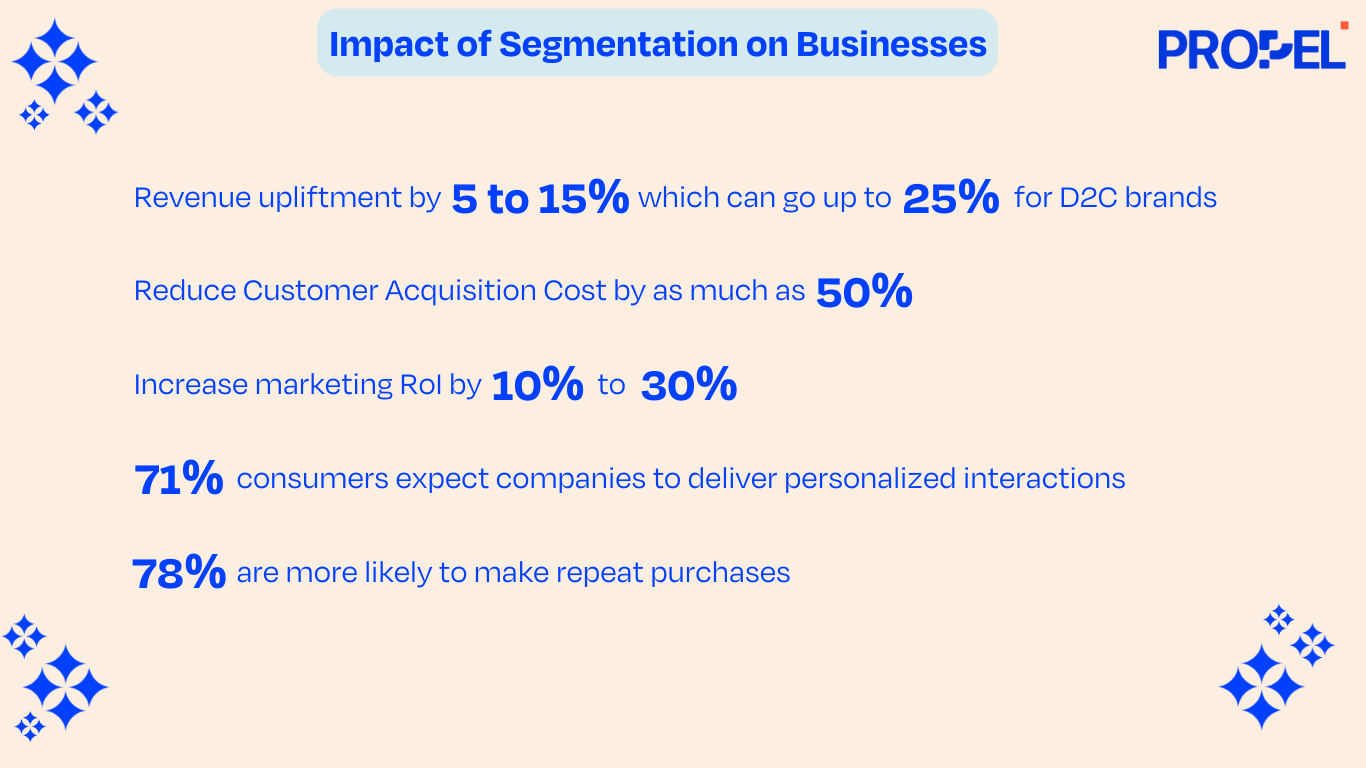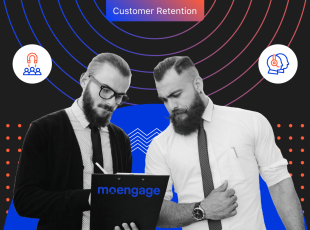In today’s highly competitive business landscape, delivering personalized experiences to customers has become essential for success. The era of one-size-fits-all marketing is over; every customer now expect tailored communication and offers that meet their specific needs. This is where customer segmentation plays a critical role.
Customer segmentation allows businesses to divide customers into distinct groups based on shared characteristics. These characteristics can include demographics (age, gender, income), behavior (purchase history, website activity), psychographics (lifestyle, values, interests), or firmographics (company size, industry). By creating these targeted segments, companies can refine their marketing strategies and enhance customer satisfaction thus increasing the efficacy of Lifecycle Marketing.
Segmentation offers numerous benefits for businesses. It enables companies to allocate resources more effectively by focusing on the most profitable segments. Additionally, segmentation leads to higher customer retention as tailored offers and communication build stronger relationships. Ultimately, by understanding their customers better, businesses can increase revenue through targeted marketing campaigns and product development.
This article will delve into the concept of customer segmentation, exploring its different models and strategic importance. We will also discuss practical methods to implement segmentation successfully, including data collection and analysis, segment identification, and tailored marketing strategies. Furthermore, we will address common pitfalls to avoid, such as over-segmentation and lack of data quality.
Customer segmentation is the process of strategically dividing a company’s customer base into smaller, more manageable groups based on shared characteristics. These characteristics can include demographics (age, gender, income), behavior (purchase history, website activity), psychographics (lifestyle, values, interests), or firmographics (company size, industry). By understanding these distinct segments, businesses can tailor their products, services, and marketing efforts to meet the unique needs of each group.
The customer segmentation process begins with data collection and analysis. Businesses can gather data from various sources, including website analytics, CRM systems, mobile app usage, and customer surveys. Once the data is collected, it’s analyzed to identify patterns and trends among customers. This analysis can be done manually or with the aid of specialized data analysis tools.
The identified patterns are then used to create customer segments. These segments can be as broad or narrow as needed, depending on the business’s goals and the level of granularity desired. For example, a company might segment its customers based on age, gender, and location, or it might create more granular segments based on purchase behavior, interests, and lifestyle.
Once the segments are defined, businesses can tailor their marketing messages and offerings to each group. This targeted approach can lead to increased customer engagement, higher conversion rates, and improved customer satisfaction.
The various types of segmentation includes:
Customer segmentation is a cornerstone of data-driven marketing, providing businesses with a powerful tool to understand their customers and tailor their strategies accordingly. By segmenting your customers into distinct groups based on shared characteristics, businesses can focus their efforts on the most profitable segments, enhance customer experiences, and drive increased sales and revenue. Using customer segmentation companies have achieved a 20-30% increase in Customer Lifetime Value (CLV)
Segmented campaigns ensure that the right messages reach the right audience at the right time. For instance, brands like Amazon use behavioral segmentation to re-engage customers who abandon their shopping carts, offering personalized deals to encourage purchases. This targeted approach not only improves campaign effectiveness but also optimizes marketing budgets by avoiding wasted resources on irrelevant segments. Besides targeted messaging allows a buyer to be guided through a seamless customer journey.
Different customers have different push-pull points. By understanding their needs and preferences, companies can enhance customer experiences through personalized offers, recommendations, and communication. For example, Netflix’s use of segmentation through its recommendation engine significantly boosts user engagement and reduces churn by suggesting content aligned with viewer preferences. By creating a sense of connection and value, businesses can foster customer loyalty and reduce customer attrition.
Effective segmentation drives higher conversion rates by targeting specific customer groups with relevant offers. As seen in McDonald’s cultural segmentation strategy, personalized marketing not only attracts more customers but also encourages repeat business, increasing long-term revenue. By understanding their customers’ needs and preferences, businesses can develop products and services that resonate with their target market, leading to increased sales and market share. In fact the benefits of segmentation trickles down the funnel giving a boost to customer loyalty as well.

Typical Segmentation Categories
Effective customer segmentation requires a systematic approach that involves data collection, analysis, and segment creation. Here’s a breakdown of the key steps:
To create meaningful segments, it’s essential to collect a variety of customer data. This includes:
Several tools can assist in the segmentation process, including:
Once you’ve collected and analyzed the necessary data, you can use product analytics software to group customers with similar attributes. This process involves identifying patterns and trends in the data and creating segments based on those insights.
To ensure that different customer segments are relevant and effective, it’s important to test them by running targeted campaigns. Compare the performance metrics of these campaigns to assess whether the segments are delivering the desired results.
When creating customer segments, consider the following factors:
Effective customer segmentation requires striking the right balance between breadth and specificity. If segments are too broad, they may fail to capture meaningful differences between customer groups. This can result in ineffective campaigning that waste resources and fail to resonate with customers. On the other hand, overly narrow segments can also be problematic. These segments may be too small to justify targeted marketing efforts and can lead to increased marketing costs.
Data is the foundation of customer segmentation, but misinterpretation can lead to poorly defined segments that do not align with customer behavior. For example, if a company mistakenly assumes that all customers in a certain age group have similar preferences, they may miss out on opportunities to target specific subsegments within that group.
To avoid misinterpretation, businesses should validate their segmentation models through A/B testing and customer feedback. A/B testing allows companies to compare the effectiveness of different campaigns targeted at different segments, helping to identify any inaccuracies in their segmentation models.
Customer feedback is essential for avoiding segmentation mistakes. By gathering feedback from customers, businesses can gain valuable insights into their preferences, behaviors, and satisfaction levels. This feedback can be used to identify any gaps in the current segmentation model and make necessary adjustments.
For example, Olay uses feedback-driven data to offer tailored product recommendations to its customers. By collecting data on customer preferences and purchase history, Olay is able to create highly personalized marketing campaigns that resonate with its target audience. This approach not only improves customer satisfaction but also drives sales and loyalty.
To determine the effectiveness of your customer segmentation model, it’s crucial to track and analyze key performance indicators (KPIs). These metrics can provide valuable insights into the impact of your segmentation efforts on customer engagement, conversion rates, and overall business outcomes.

Description: Impact of Segmentation and Personalization on Businesses (Source: McKinsey)
A/B testing is a powerful tool for validating your segmentation model. By creating two or more versions of a marketing campaign and targeting them at different segments, you can compare their performance to determine which approach is more effective. This helps you identify any inaccuracies in your segmentation and make necessary adjustments.
Analytics platforms like Google Analytics and marketing automation tools such as Braze offer real-time insights into campaign performance, allowing you to make data-driven adjustments. These tools can help you track key metrics, analyze customer behavior, and identify trends that can inform your segmentation strategy.
Artificial intelligence (AI) and machine learning are revolutionizing the way companies segment their customers. These technologies enable businesses to discover hidden patterns and correlations within vast datasets that would be impossible to identify manually. By analyzing customer data at scale, AI can create more precise and granular segments, leading to more targeted and effective marketing campaigns.
Predictive analytics, a subset of AI, can also be used to forecast customer behavior. By analyzing historical data and identifying trends, businesses can anticipate customer needs and personalize their experiences in real-time. This level of personalization can significantly improve customer satisfaction, loyalty, and revenue.
Personalization will continue to be a driving force in future segmentation strategies. As consumer expectations grow, customers will demand increasingly tailored experiences across all touchpoints. Businesses that can deliver hyper-personalized experiences will have a significant competitive advantage.
AI and machine learning will play a crucial role in enabling personalization at scale. By leveraging these technologies, companies can create highly personalized marketing campaigns, product recommendations, and customer service interactions.
To stay competitive in today’s data-driven landscape, companies must invest in advanced segmentation tools and technologies. This includes adopting AI-powered analytics platforms and leveraging machine learning algorithms to uncover hidden insights within their customer data.
Additionally, companies should continually refine their segmentation models based on the latest data and trends. By staying up-to-date with industry best practices and emerging technologies, businesses can ensure that their segmentation strategies remain effective and relevant.
Customer segmentation is a powerful tool that helps businesses unlock the full potential of their marketing efforts. By grouping customers into meaningful segments, companies can tailor their strategies, improve retention, and increase revenue. However, successful segmentation requires the right mix of data, tools, and continuous optimization to remain relevant.
As technology evolves, businesses must stay ahead by adopting AI-driven insights and personalization strategies. Those who invest in effective segmentation will not only deliver better customer experiences but also secure a competitive edge in the marketplace.

Rushabh Menon is a seasoned B2B growth and product marketing leader currently heading GTM strategy at Propel. With a strong foundation in strategic planning and execution, he is known for his analytical approach and commitment to impactful, data-driven marketing. An alumnus of IIT Madras and IIM Shillong, Rushabh brings valuable expertise in driving market expansion with a focus on continuous learning and improvement.
Got Questions? We Have Answers!
It ensures tailored customer experiences and personalized messaging enhancing satisfaction and loyalty.
Accurate data collection and insightful analysis are key.
Targeted offers and communication build stronger relationships, reducing churn.
CRMs, analytics, and marketing automation platforms streamline the process.
AI enables real-time personalization, improving engagement and revenue.


Propel specializes in customer lifecycle marketing, helping consumer brands boost retention & reduce churn with tailored strategies and our AI-augmented platform, AURA.
Book a call with our experts and get started today!